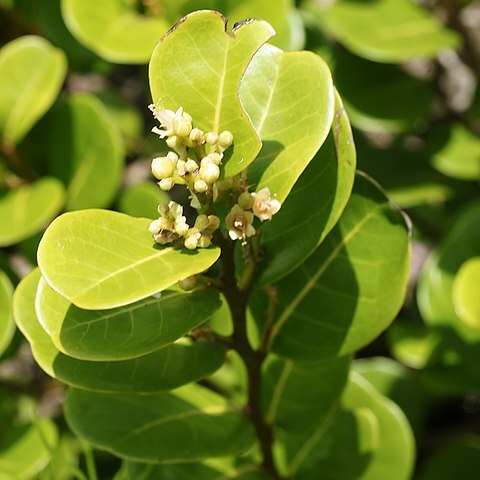Trees or shrubs. Leaves simple, petiolate, entire; blade with two small basal glands. Flowers with a shallow receptacle. Calyx-lobes and petals 5. Stamens 15 or more, all or partly fertile, the filaments usually partly united towards the base, inserted all round the rim of the receptacle. Carpel single, sessile, inserted at the base of the receptacle. Fruit drupaceous, with a large stone.
A small (possibly monotypic) genus of shrubby plants with entire coriaceous leaves. Flowers white, in axillary cymes; calyx (hypanthium) perigynous, the lobes 5; petals 5; stamens about 20, hirsute, coherent; ovary sessile at the bottom of the hypanthium; ovules 2; style basal. Fruit a drupe with one bony stone having 5-6 angles.
Shrubs or trees. Leaves persistent; blade margins entire. Thyrses axillary or terminal. Flowers: petals 5; stamens [12–]14–22[–26], filaments connate basally to 1/3 length in groups, densely hairy proximally; ovary densely hairy; styles densely hairy. Drupes globose or broadly ellipsoid; endocarp longitudinally ribbed. x = 11.
Drupe small, glabrous; endocarp thin, hard, interior glabrous, exterior smooth, with 4–8 prominent longitudinal ridges corresponding to the lines of fracture that allow the seedling to escape.
Stamens 12–26, forming a complete circle; filaments hairy, c. twice as long as sepals, appearing slightly united at the base.
Inflorescence few-flowered, a short raceme of cymules or cymose throughout, or a false raceme or a subsessile fascicle.
Ovary monocarpellary, 1-locular, inserted at base of receptacle, covered with a dense mass of hairs.
Lower leaf-surface glabrous or with a few stiff appressed hairs.
Styles puberulous; stigma slightly expanded, shallowly 3-lobed.
Receptacle-tube cupuliform, interior and exterior puberulous.
Small or medium-sized trees or shrubs.
Petals 5, longer than the sepals.
Sepals 5, acute, subequal.
Bracts small, eglandular.
Flowers actinomorphic.

